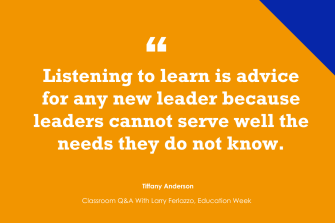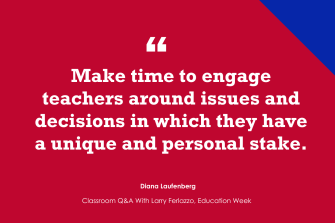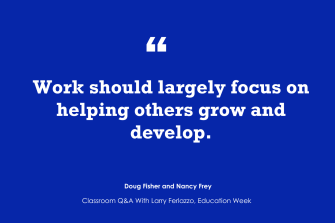School district superintendents have a big job to do.
Some do it well and some do it not so well.
Here’s advice educators would offer them on how they could do more of the former and less of the latter.
Listen!
Recognized as one of Education Week’s Leaders To Learn From in 2015, Tiffany Anderson is the first Black female superintendent of the Topeka public schools in Kansas. Her leadership has been recognized with three Magna Awards from the National School Boards Association and the AASA Women in School Leadership Award:
The top two pieces of advice I would offer to a superintendent are:
1. Listen to learn before responding.
2. Support systems that build student, staff, and parent capacity.
Listening to learn is advice for any new leader because leaders cannot serve well the needs they do not know. The pressure to improve outcomes and take action quickly can cause new superintendents to become transactional as they seek quick wins and not transformational-seeking, sustainable long-term results that improve systems. Listening to learn elevates voices and gives access to the superintendent.
Listening to learn can occur through listening tours in schools for staff, the community for parents, and in school clubs and classrooms for students. Often, people listen to respond first; my advice to a new superintendent, based on my 20 years as a superintendent, is to listen to learn.
I have learned that in order to build ownership within the entire community and to work collaboratively as co-creators of new systems, listening to learn before responding is critical to developing sustainable outcomes and strategic plans focused on continuous improvement.
The second piece of advice is to support systems that build student, staff, and parent capacity, and it is what led to my new book published by Corwin in May entitled Building Parent Capacity in High Poverty Schools: Actions for Authentic Engagement. Programs come and go, but systems remain, and in order for a superintendent to build a strong system, superintendents, principals, and teachers need the support of parents.
Parents are a child’s first teacher, and as superintendents lead districts with schools in the center of community, parents who live in the community must be collaborative partners, and their capacity to effectively engage, advocate, and empower others in support of student success will greatly impact the district.
As new superintendents work with board members who are voted in by parents and who are often parents themselves, their effectiveness depends largely on the board support they gain. Building parent capacity is a primary lever that will strengthen the collective system in support of students and staff.

‘Stability Is Paramount’
For 16 years, Diana Laufenberg taught 7-12 grade social studies in Wisconsin, Kansas, Arizona, and Pennsylvania. She currently serves as the executive director and lead teacher for Inquiry Schools:
1. Do your job. The superintendency is a big job. It requires a set of skills that often require knowledge from business/finance, pedagogy, human resources, etc. Hire competent people that are spectacularly clear communicators. Oversee the business of the schools with deliberation and skill so as to allow for those working in the district to be awesome. Poor communication, mismanaged budgets, and rash decisions can upend progress, stability, and commitment to the district.
As someone who worked through a massive district budget mismanagement, (so bad they stopped buying paper in January), I can tell you there is nothing more important than you doing your job in the most mundane and officious way. Once you are accomplishing that, then you can get to the fun stuff I include below. Foundational stability is paramount to setting everyone else up for success.
2. Be present. If you are in a smallish district, visit every classroom as frequently as possible. If a larger district, visit every school as frequently as possible. While you are there, talk to students and teachers. Ask them what is important to them, what small things could make their day better, and what hopes they have for the future. Take notes.
Schools are human systems. If you are going to be great at your job, you definitely need to know and listen to the humans. While you are there, invite the parents to chat you up at a coffee break. Participate in the community as an active member. Don’t make the community come to you with events focused on you and your ideas as your sole point of connection. Meet the students, teachers, and parents where they are.
3. Include students and teachers as much as possible when making decisions. The siloed and insulated thinking at the district level continues to be one of the most exasperating parts of school systems. Include students and teachers in your decisionmaking as much as humanly possible. Convene short listening sessions as needed. Put high school students in an advisory role to the board or superintendent.
Make time to engage teachers around issues and decisions in which they have a unique and personal stake. If the only people advising you in your decisionmaking do not spend a majority of time in a school, you are not going to be making the most informed decisions for the district. Human systems require a superintendent to intentionally and thoughtfully engage with the humans in that system.

‘Dream Managers’
Doug Fisher and Nancy Frey are both professors of educational leadership at San Diego State University:
Senior leaders in school systems get a lot of advice, much of which is unsolicited. There are so many things that superintendents must juggle and there are thousands of decisions to be made. Staying true to your vision and aligning resources with that vision are important aspects of the work. If we were to offer a little advice, based on more than 20 years supporting senior leaders in instruction, we would suggest the following:
Build an instructional framework. Many of the most successful school systems clearly articulate how teaching and learning occur within their organization. There are so many different instructional models and language that are used to describe the moves that teachers make that ensure learning.
Without a clear framework (which should not prescribe how teaching works but rather outline instructional moves), educators have a hard time talking with each other because the terminology they use differs. This has an impact on the way that people understand and implement professional learning experiences. When instruction is left to be interpreted by the individual, rather than through shared agreements, getting to scale is difficult.
When a school system engages in a process to define what they collectively believe about teaching and learning, the likelihood of alignment increases. Professional learning, coaching, feedback, and impact can be more easily discussed, and deeper understanding is more likely to be reached when people share the same vocabulary and meaning. As one example, Long Beach Unified in California developed (and continues to refine) their understandings and expectations for quality core instruction This instructional framework guides the work they do, from new teacher induction to policy development.
Define your portrait of a graduate. Similar to the work on an instructional framework, identifying the product of the school system allows people to share their perspectives and reach consensus about the why—why do we exist, and what do we expect to produce? This process allows the system to analyze its mission and to articulate the vision that various stakeholders have for future-ready graduates who engage in deep learning.
This also allows every member of the school community, not just the teaching staff, to identify the role that they play in fostering the skills and dispositions articulated in the portrait that has been painted. In addition, the portrait of a graduate can increase alignment across grade levels as each teacher learns how they will contribute to the long-term success of students. Further, the portrait of a graduate is not limited to academics but rather includes a wide range of competencies that the community finds valuable.
As one example, the Mesa school district in Arizona engaged in a collaborative process to articulate what they believe should be included in their portrait of a graduate.
Cultivate dream managers. The people in your organization have hopes and dreams for their futures, both professionally and personally. When leaders see their role as inclusive of serving as a dream manager for the people they supervise, employees’ support for the organizational mission increases.
Dream managers help people plan to accomplish their dreams. They make connections and offer advice. Think about that new teacher who wants to buy a home and have a family but doesn’t know where to start. What introductions and plans could a dream manager play? What about the paraprofessional who wants to become a teacher but isn’t sure how to allocate time and finances? And what about the maintenance worker who aspires to own a business?
Reading The Dream Manager (Kelly, 2015), we realized that our work should largely focus on helping others grow and develop, reaching their dreams. When leaders adopt the role of dream managers, the organization’s culture and climate become more positive, and people are more likely to give their best efforts because they feel supported in accomplishing more.
Note that each of these allows various educational partners to share their perspectives and feel heard. In doing so, they are much more likely to support the initiatives of the district and engage in the work required to realize the vision. There are many, many other things that superintendents need to do to be successful, but these three can facilitate greater commitment to the organization and pay dividends for years to come.

Thanks to Tiffany, Diana, Doug, and Nancy for contributing their thoughts!
Today’s post answered this question:
What one to three pieces of advice would you offer to a superintendent of a school district, and why would you offer those specific suggestion/s?
Consider contributing a question to be answered in a future post. You can send one to me at lferlazzo@epe.org. When you send it in, let me know if I can use your real name if it’s selected or if you’d prefer remaining anonymous and have a pseudonym in mind.
You can also contact me on Twitter at @Larryferlazzo or on Bluesky at @larryferlazzo.bsky.social .
Just a reminder; you can subscribe and receive updates from this blog via email. And if you missed any of the highlights from the first 13 years of this blog, you can see a categorized list here.






